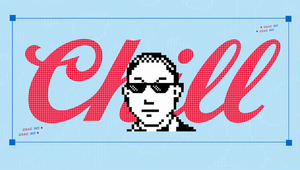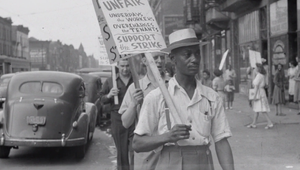
Shadows, Dragons, Cities: Delving into Accenture Song’s VFX Work on Netflix’s Shadow and Bone

In Shadow and Bone, Netflix’s fantasy TV series, we follow Alina Starkov - an orphaned cartographer who discovers that she possesses extraordinary abilities. Set in the fictional ‘Grishaverse’, Shadow and Bone's worlds take inspiration from real countries at different points in history including their culture, language, and architecture while imbuing them with magical elements. It’s also full of shadowy figures known as the ‘Nichevo’yas’ and the second season features a magnificent dragon, Sea Whip – a creature of beauty and menace.
With the second season airing in March of this year, the show has picked up an Emmy nomination in the Outstanding Special Visual Effects in A Single Episode category for ‘Rusalye’. This episode is special to Apollonia Hartmann, VFX producer at Accenture Song, who worked on its multiple special effects, as it debuts the aforementioned Sea Whip and Ketterdam, a bustling trade hub city.
Appollonia says that the team were given free reign at the design stage with Sea Whip and the team flexed their creative and technical muscles to make the creature look native to water with additional alligator-like characteristics which can be spotted in its gait. Generating a consistent look between the footage shot and the VFX was a huge focus and task for the team - it all came down to considering how light works in a space (a cave, in this instance) and integrating the Sea Whip creature into the environment. Working on the Nichevo’yas was another challenge; their look was already established in season one, so the team had to match them perfectly. Each shadowy figure is a heavy simulation consisting of 100 million particles and the team simulated the longest shot for over 24 hours.
LBB caught up with Appollonia to find out how the team made Sea Whip come to life, why trust and creative freedom were at the heart of how they worked, and what the Emmy nominations means to everyone who worked on ‘Rusalye’.
LBB> How did Accenture Song first get involved with Shadow and Bone? What was the brief like and what were your initial thoughts?
Appollonia> The Accenture Song VFX team has worked together successfully with client-side VFX supervisor Ante Dekovic on previous shows (Star Trek: Picard and Star Trek: Discovery). Ante was very happy with our work and additionally has known our former VFX supervisor, Juri Stanossek, for a long time. That is why Ante reached out to us when he started to look for vendors for Shadow and Bone season two.
Our main body of work were the creatures, Sea Whip and Nichevo’yas, and the city build of Ketterdam. The Sea Whip is one of the main creatures of season two, and it had to be designed from scratch. The client entrusted us with the design phase, which we started very early, long before the scene was shot. Afterwards, we built the asset based on our concepts.
The brief was to design a dragon-like creature whose natural habitat is the water but can also walk on land like a lizard or alligator. It should look mysterious and dangerous. From a storytelling perspective, it was very important that the Sea Whip should have the ability to camouflage against the environment it is featured in.
Our thoughts? Hell yes! We were excited and looking forward to facing that challenge! Plus, it is a dragon-like creature, and everyone loves dragons.

Above: still featuring Sea Whip
LBB> Tell us a little bit about the aesthetic of Shadow and Bone and how the VFX contributed to the show’s overall look and feel.
Appollonia> To generate a consistent look between shot footage and VFX, one of the most important things is to match the lighting. The Sea Whip sequence, for example, takes place in a cave where there are not many light sources. A threatening mood is to be told. We therefore had two goals in lighting: make the Sea Whip look very mysterious as well as dangerous and make sure we integrated all the elements very well: the water, the cave, the actors and the Sea Whip. The look of the Nichevo’yas was a combination between smoke and particles. The Nichevo’yas has been established in season one already. Our approach, therefore, was to match the look.

Above: still featuring the Nichevo'ya from season two
LBB> We have to ask about the dragon that appears in the show - it’s a truly magnificent, visually arresting creature. What was the creative process behind it like?
Appollonia> Thank you! As I mentioned before, we were involved in the creative process of the Sea Whip from the beginning. Our art director created rough 2D concepts based on the client briefing. He sketched different options for each body part, for example, different tongue and fin shapes. We actually offered a Sea Whip configurator.
After the client approved the main shape, we started to build the Sea Whip in 3D to coordinate the details with the client. Having a 3D model and sculpt helped present all features in the right scale. In this phase, our art director worked hand in hand with our Sea Whip asset supervisor. In the end, it was a dynamic process.
LBB> What was your working relationship like with the show’s creators - how much creative freedom did you have?
Appollonia> Our relationship was amazing! It may seem platitudinous to start with that sentence, but that is really how it was. I have already mentioned that Ante and Juri have known each other for a long time. I would describe their relationship as one of trust and respect. We had no direct contact with the executive producers but we received their feedback in written form. It was always understandable, or Ante managed to convey the producers' wishes in a way we could understand. Ante gave us great creative freedom and was able to communicate his feedback clearly. I think that is another reason why there were hardly any iterations in the Sea Whip design and asset build phase. This refers not only to the Sea Whip sequence but also to the overall show.
LBB> Juri Stanossek, your former VFX supervisor, and the team are nominated for an Outstanding Special Visual Effects In A Single Episode Emmy for the episode ‘Rusalye’. What’s special about this episode from a VFX angle?
Appollonia> It’s very exciting and it would not have been possible without our team. The artists working at Accenture Song burn for their work and always go the extra mile. From our point of view, ‘Rusalye’ is special because this is the only episode in which we see the Sea Whip and establish Ketterdam for the first time.

Above: still featuring Ketterdam
LBB> And how do you feel about the VFX team picking up two nominations in the category in the same year?
Appollonia> This is absolutely fantastic because the double nomination distinguishes us as an entire department and proves that we are strong as a team.
LBB> Did you encounter any challenges while working on the show? If so, how did you overcome them?
Appollonia> Someone once told me that if there were no challenges, it would not be the VFX industry. Thinking back on it, I would say that building the city of Ketterdam was challenging because it was a massive task from planning a city almost from scratch and making it for shot work. When our Art Director designed the city, he, on the one hand, focused on building a beautiful city with readable landmarks and, on the other hand, he had to consider the location of the scenes that were given. Bringing it all together down to the last house was a challenge. Besides, we had a few challenging moments with the Nichevo’ya shots simply because they were heavy simulations. Just one Nichevo’ya consists of about 100 million particles. The longest shot has been simulated longer than 24 hours. If the result does not look the way it should, it can be quite a hassle to find the error.
Being honest with the client about challenges helps. Not only artists and producer/supervisor are a team, but also the client and us. If I handle challenges transparently, my client can understand why maybe shots are delivered later. I try to help my team with structure by setting smaller milestones. Trust is the key here, making everyone involved feel we are all one team.
LBB> Finally, what are your and the team’s highlights from working on Shadow and Bone?
Appollonia> Definitely the Sea Whip but also the Nichevo’yas and Ketterdam. One of my personal highlights was visiting the production on set together with Juri while they shot the Sea Whip sequence.















